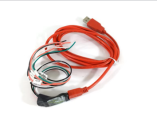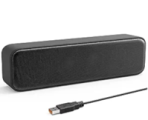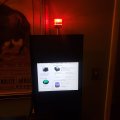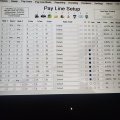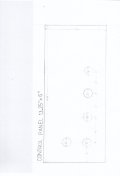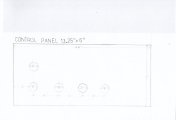Key West Resort & Casino Project Report:
ADDING HARDWARE TO STEP UP OUR SLOT MACHINE GAME!
ADDING HARDWARE TO STEP UP OUR SLOT MACHINE GAME!
Background:
Since 2021, I've been running slot machine software on a touchscreen laptop and mirroring it onto a large touchscreen monitor. The software, from AllJ Slots, puts three slot reel images on your screen and allows you to customize the screen background and even the images on the reels. Multiple control panels allow you to add or subtract reel images and stops to tweak the payout percentages and win rates, which it also records and reports. In short, you can turn it on, close the laptop and play by touching the on-screen buttons on the big monitor. It runs like a real slot machine. On a 24-inch touchscreen mounted in "portrait" mode, it looks like this: (Custom slot reel images are shown below.)
Right now, the "slot" is running using images of IGT buttons on the screen. Touch them and the slot reels react accordingly. But the software is compatible with an array of real slot machine hardware -- real IGT buttons, lights, beacons, and even cash out receipt printers, coin and bill acceptors and hoppers. My goal, over time, is to add peripheral hardware to create an even more realistic player experience by adding new things and sharing the results -- successes, failures, challenges and what I learn -- here.
Here's a list of what is here or ordered right now. I'm still waiting for most of it to arrive. That will happen in the next couple of weeks:
LEFT TO RIGHT: A: The IGT buttons; B: IGT button control module; C: Slot machine beacon light; D: Cash out voucher printer; E: Speaker; F: 4-port USB hub. (Lots of things connect through USB cables) Total cost for the above items: $405.
and, of course, my "pie-in-the-sky" TITO (Ticket-in / Ticket Out) system, ordered just today. I found this refurbished one at a casino equipment supplier for $110. A new one is normally $650. AllJ says the program will send the voucher to any printer we program into the the laptop. I'm not sure it will work with the software or if we can eventually make it work, but it's worth a hundred bucks to find out.
Q: So why not just buy a slot machine?
A: Real, full-sized slot machines are too big, too heavy (400 pounds and up) and can get really expensive to buy and maintain. If I build a working machine, I'll learn a lot and have a better understanding of how it works and how to fix it when it stops working. And the best reason of all: For the hell of it.
What are the challenges:
Cost: Obviously, if you want, and you have the cash, you can buy a real slot machine. I know a couple of people who have the real McCoy, complete with TITO systems.
The same goes for a project like this. I'll be limited by the affordability of the add-ons. Example: A bill acceptor that takes real money can cost around $1,200, so I won't be adding one of those. Slot machine arms? There's one online right now for $400, so that's a "no." (It's a simple USB keystroke emulator programmed to say "spacebar," so I could probably have one made for less.)
My budget on this is $1,500 to $2,000.
To date, I've spent $399 for the software and $265 for the touchscreen monitor, both in 2021. (I have two spare laptops, so that cost is $0. All the above items together cost another $515, this year, but one of the printers will be returned or sold for around $100. So total to date would be $1,069... or the price of a new cell phone.
Time: These days, it takes days or weeks to get stuff, or to find someone working in tech or customer service. I expect this project to take a year or more and be done in several phases: 1) Obtaining and testing hardware; 2) Resolving compatibility and tech issues; 3) Designing a nice slot cabinet; 4) Building the cabinet; 5) Installing the hardware. My estimated time to complete this project is 4 to 6 months.
Me: I'm not the "guy from IT." I don't write code or work in the tech industry. So if I can do this, I'm sure you can, too.
Attachments
Last edited:

